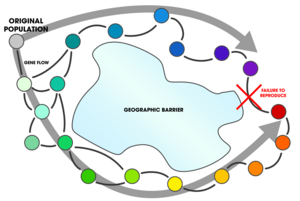
Back نوع حلقي Arabic Кръгов вид Bulgarian চক্র প্রজাতি Bengali/Bangla Prstenasta vrsta BS Prstencový druh Czech Ringart Danish Ringspezies German Especie en anillo Spanish گونه حلقهای Persian Rengaslajit Finnish


In biology, a ring species is a connected series of neighbouring populations, each of which interbreeds with closely sited related populations, but for which there exist at least two "end populations" in the series, which are too distantly related to interbreed, though there is a potential gene flow between each "linked" population and the next.[1] Such non-breeding, though genetically connected, "end populations" may co-exist in the same region (sympatry) thus closing a "ring". The German term Rassenkreis, meaning a circle of races, is also used.
Ring species represent speciation and have been cited as evidence of evolution. They illustrate what happens over time as populations genetically diverge, specifically because they represent, in living populations, what normally happens over time between long-deceased ancestor populations and living populations, in which the intermediates have become extinct. The evolutionary biologist Richard Dawkins remarks that ring species "are only showing us in the spatial dimension something that must always happen in the time dimension".[2]
Formally, the issue is that interfertility (ability to interbreed) is not a transitive relation; if A breeds with B, and B breeds with C, it does not mean that A breeds with C, and therefore does not define an equivalence relation. A ring species is a species with a counterexample to the transitivity of interbreeding.[3] However, it is unclear whether any of the examples of ring species cited by scientists actually permit gene flow from end to end, with many being debated and contested.[4]
- ^ Irwin, Darren E.; Irwin, Jessica H.; Price, Trevor D. (2001). "Ring species as bridges between microevolution and speciation". Genetica. 112/113: 223–243. doi:10.1023/A:1013319217703. PMID 11838767. S2CID 7108000.
- ^ Dawkins, Richard (2004). The Ancestor's Tale. Houghton Mifflin. p. 303. ISBN 0-618-00583-8.
- ^ Brown, Rob. "'Same Species' vs. 'Interfertile: concise wording can avoid confusion when discussing evolution".
- ^ Coyne, Jerry A.; Orr, H. Allen (2004). Speciation. Sinauer Associates. pp. 102–105. ISBN 0-87893-091-4.